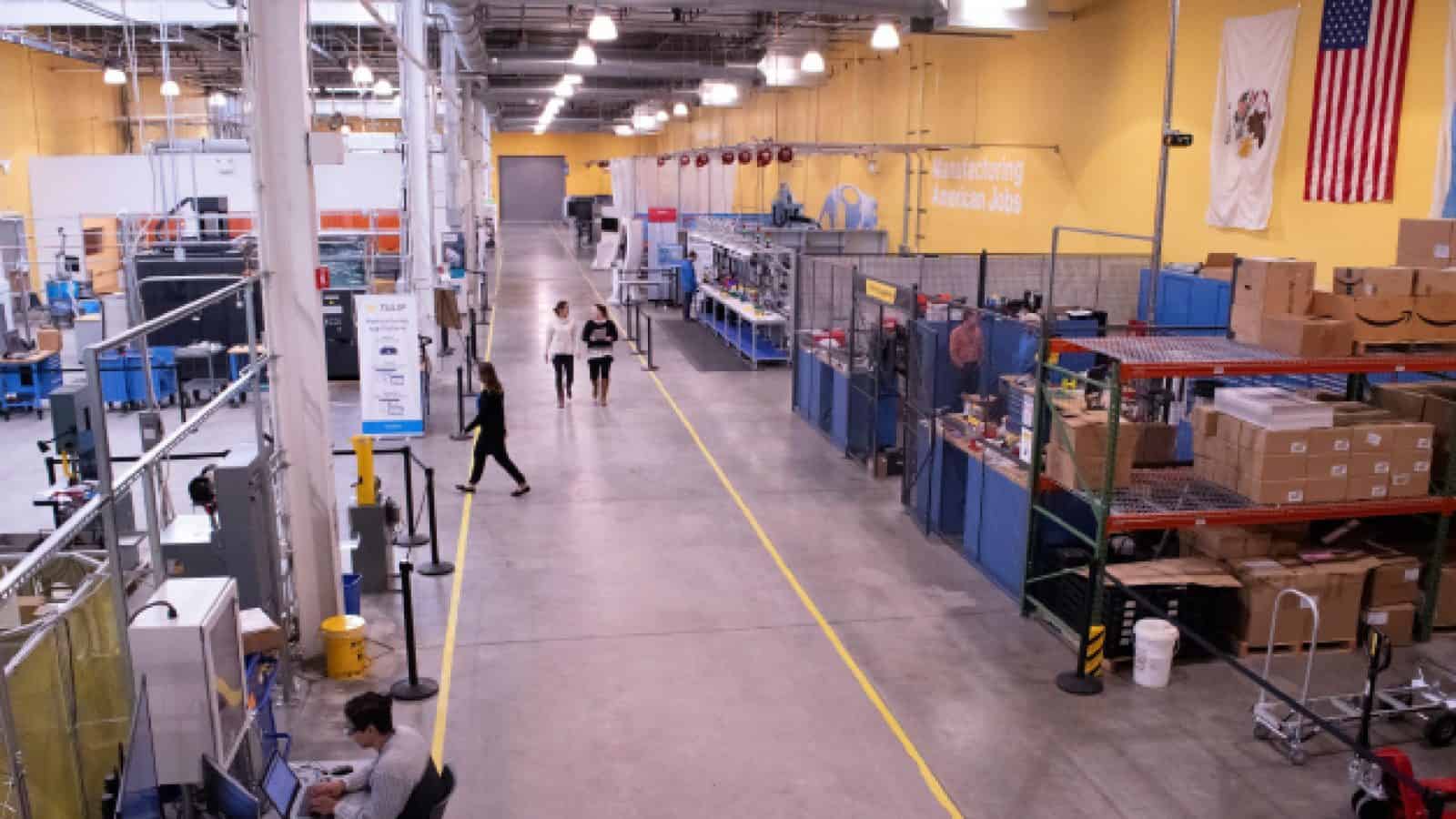Autonomy’s Path: Operations Transformed with Production Logistics
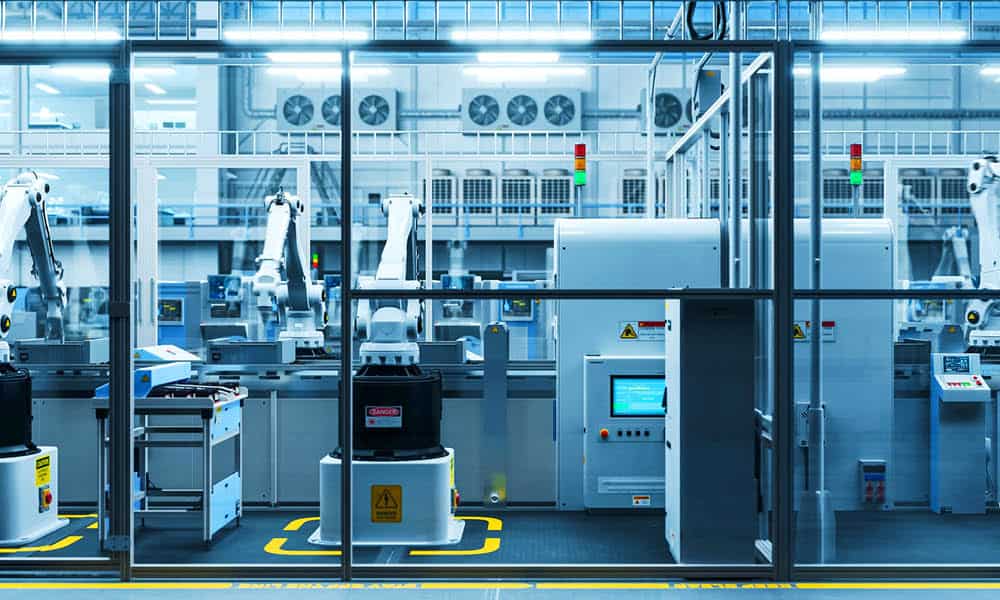
Seamless material and data flow is unlocking the next frontier of digital transformation and empowering autonomous operations.
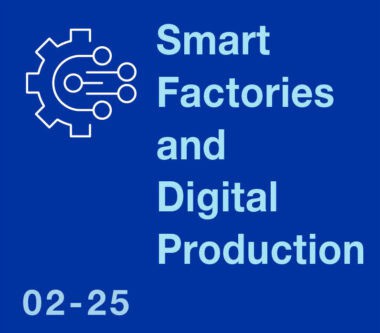
TAKEAWAYS:
● Manufacturers have focused automation efforts on primary manufacturing processes but not as often for material movement.
● Automating and optimizing material flow is essential to improved competitiveness and a gateway to autonomous operations.
● Success requires a deliberate plan and committed leadership in addition to awareness about commonly encountered challenges.
The fourth industrial revolution promises that advancements in technologies like IoT and AI will bring new levels of intelligence to manufacturing, ultimately reducing the need for human intervention in operations. Decades of investment in automation, along with the growth of digital technologies, has advanced this vision.
While manufacturers have adopted significant levels of automation in their primary manufacturing processes, material movement has mostly missed the Industry 4.0 treatment. Many sophisticated manufacturers rely on people to move material around their automated processes. Even Amazon, a leader in robotics, recently opened its most automated warehouse yet, which includes 2,500 people to support non-automated tasks, such as picking product and loading trailers.
To achieve more autonomous operations, the manual production logistics activities that exist today need to be automated and optimized, just like primary manufacturing tasks. Current market conditions are ushering in this next wave of automation and digital transformation. Rising labor costs, labor shortages, new economic policies, and worker safety concerns are accelerating investments in technologies like autonomous mobile robots, automated guided vehicles, and other automated material movement and storage systems, many of which are seeing double digit CAGRs. A recent survey of over 5,000 global manufacturers shows that the adoption of robotics, specifically AMRs and AGVs, as a top 3 investment area among manufacturers embracing digital technologies.
The end goal of this new wave of automation is to reduce labor cost, improve efficiency, and increase operational resiliency, resulting in a competitive advantage in production. Leading digital transformation roadmaps and I4.0 strategies include plans for automating and optimizing material flow – it’s directly on the path to more autonomous operations.
Defining Integrated Production Logistics
A strong production logistics capability goes beyond automating manual workflows. The automation is foundational, but it also involves orchestrating the flow of material movements and informing it with a touchless stream of data. At its core, integrated production logistics is the autonomous end-to-end flow and coordination of material movement throughout all operational functions, informed and optimized by data and insights.
- Autonomous: This implies a level of foundational automation and includes the integration of human activities with robot-supported movements, a tenet of Industry 5.0.
- End-to-end and throughout operational functions: This value is best realized when viewed holistically. The entire logistics process should be considered: planning, scheduling, receiving, unloading, staging, inbound put away, picking, prep, line delivery, line takeaway, and loading. Disruptions in one area can ripple throughout the process, destroying productivity.
- Informed by data and insights: The data generated in and around material movement systems should be digitized and treated with the same value as production data. It is a necessary input to dynamically coordinate and control flow.
Overcoming Common Challenges
Systems-level and holistic thinking is an essential step to making progress with integrated production logistics. The following challenges must also be overcome to achieve success:
- Fragmentation: The market for material movement solutions is extremely fragmented. In the Americas, the top 8 AGV and AMR vendors hold less than 50% market share collectively. This means businesses are unlikely to find one vendor to provide all the necessary hardware and software to automate and coordinate their material moves. For most, this means multi-vendor fleets and solutions, leading to complexity and at worst, process and technology silos.
- Technology limitations: MIT roboticist Daniela Rus said, “robots are still primitive compared to humans. Working on these technologies has only amplified my appreciation for the mental and physical marvel that is the human being.” The technology has greatly improved in the past three to five years, accelerated by advancements in AI, but it has limitations, including the tasks it can perform, the environments it can navigate, the loads it can move, and the speed it can operate. Companies still won’t find a single robot that can do it all. Humans and robots will continue to share space and the whole ecosystem needs to work together to achieve productivity targets.
- Cost: Production logistics investments are significant. Until relatively recently, the return on investment hasn’t always justified the automation. Today, blend high labor cost and labor scarcity with significantly improved and more affordable technology, and the investment calculus is attractive.
- Integration: Processes or facilities may not be set up for optimal flow, and the goal is not to automate a bad process. Islands of automation may have been created over the years, meaning parts of the process may be automated but those automation islands don’t communicate. Systems also may not speak the same language. Standards are progressing but challenges remain in creating an integrated solution.
To illustrate the importance of integration and interconnectedness in production logistics, consider the following scenario, which existed at a leading consumer goods company.
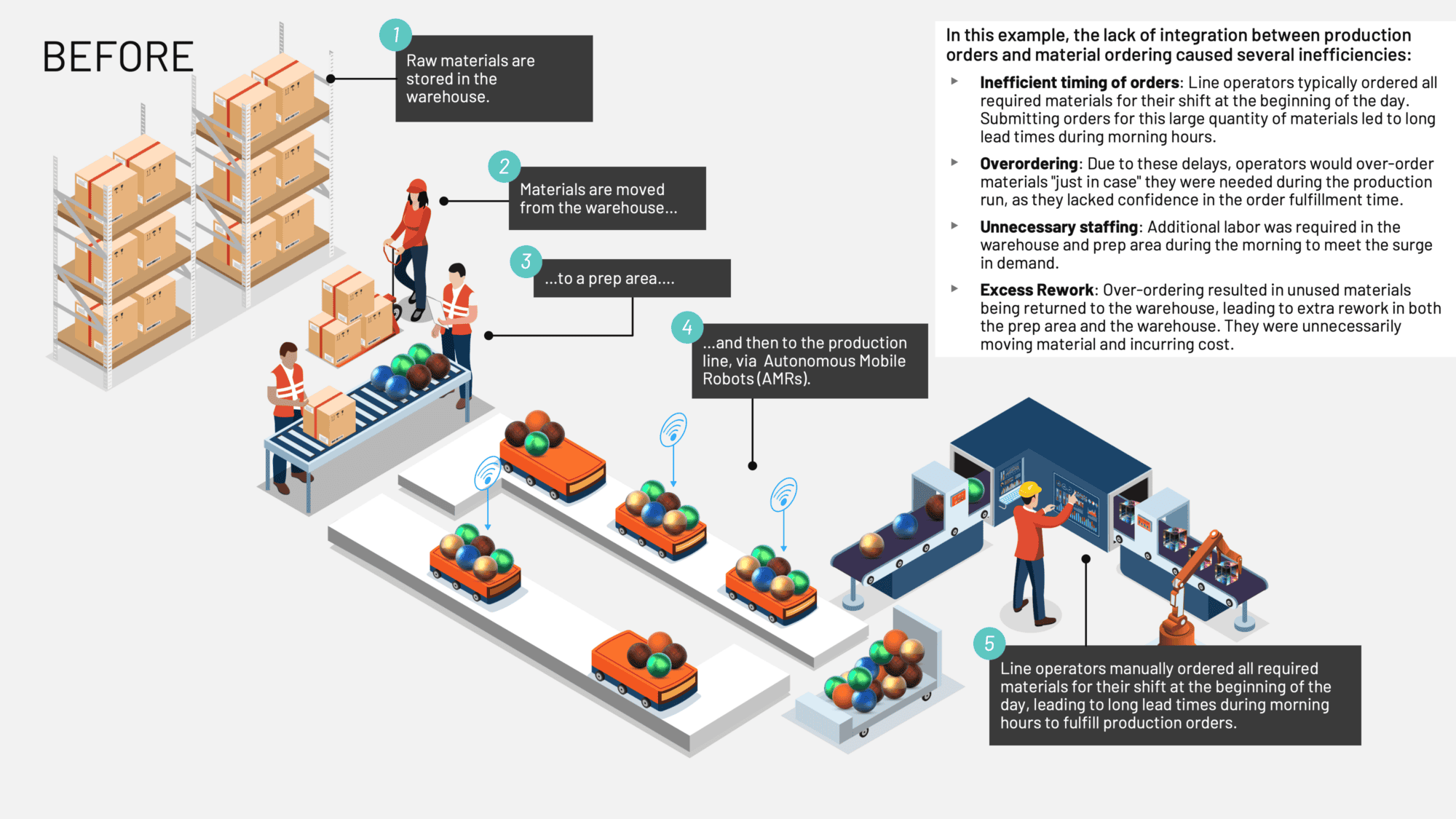
Before, a lack of integration between production orders and material ordering caused several inefficiencies including:
- Inefficient timing of orders
- Overordering
- Unnecessary staffing
- Excess Rework
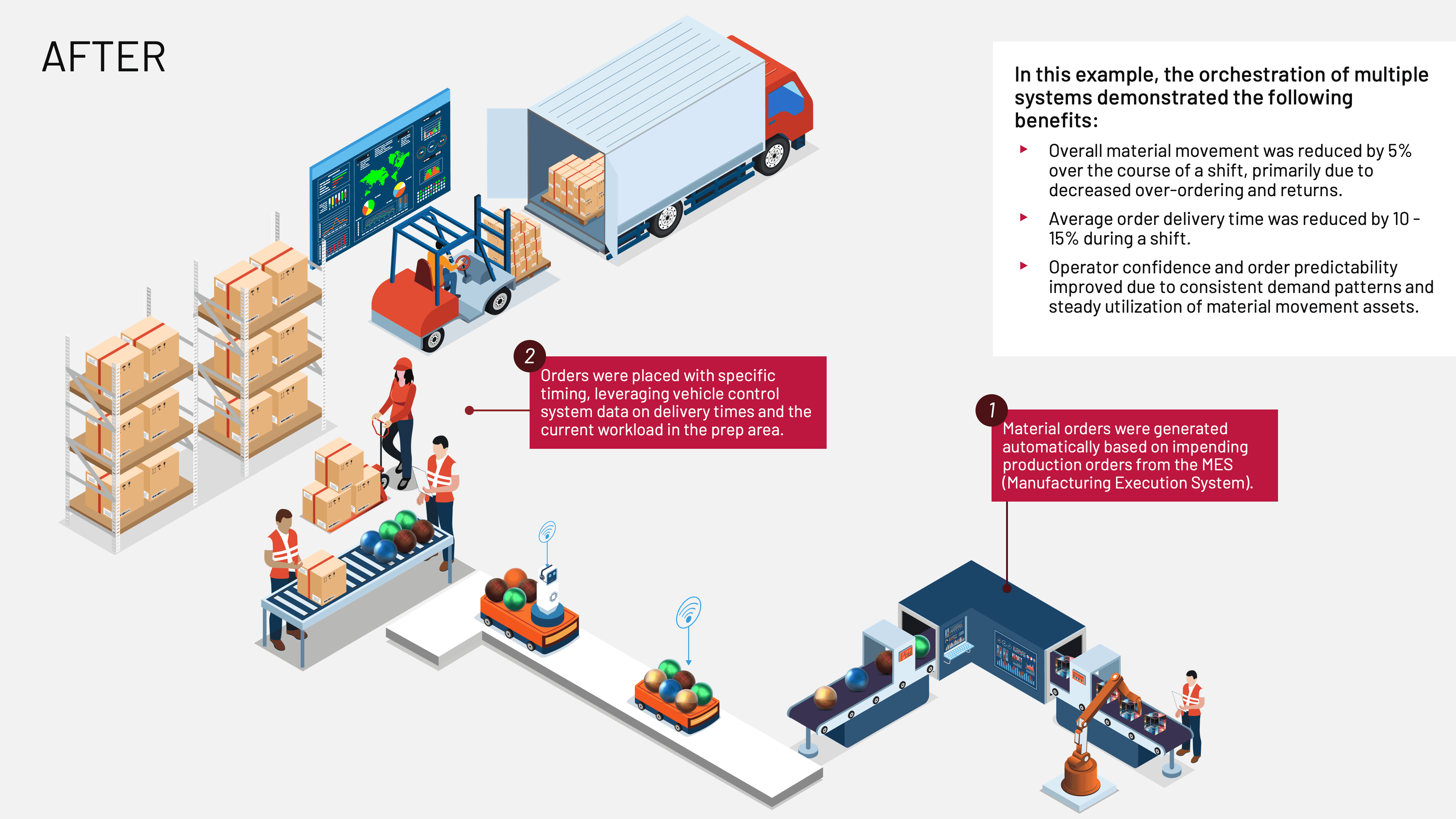
Leveraging data the operation had available, two points of integration were implemented to drive a higher level of optimization into the process. The manufacturer not only realized labor savings with AMRs, but unlocked additional value and potential by leveraging data to better integrate the operation.
Elements of a Successful Integrated Production Logistics Solution
Manufacturing leaders face numerous challenges in achieving integrated production logistics. Here are the essential building blocks to overcome these challenges and realize the benefits:
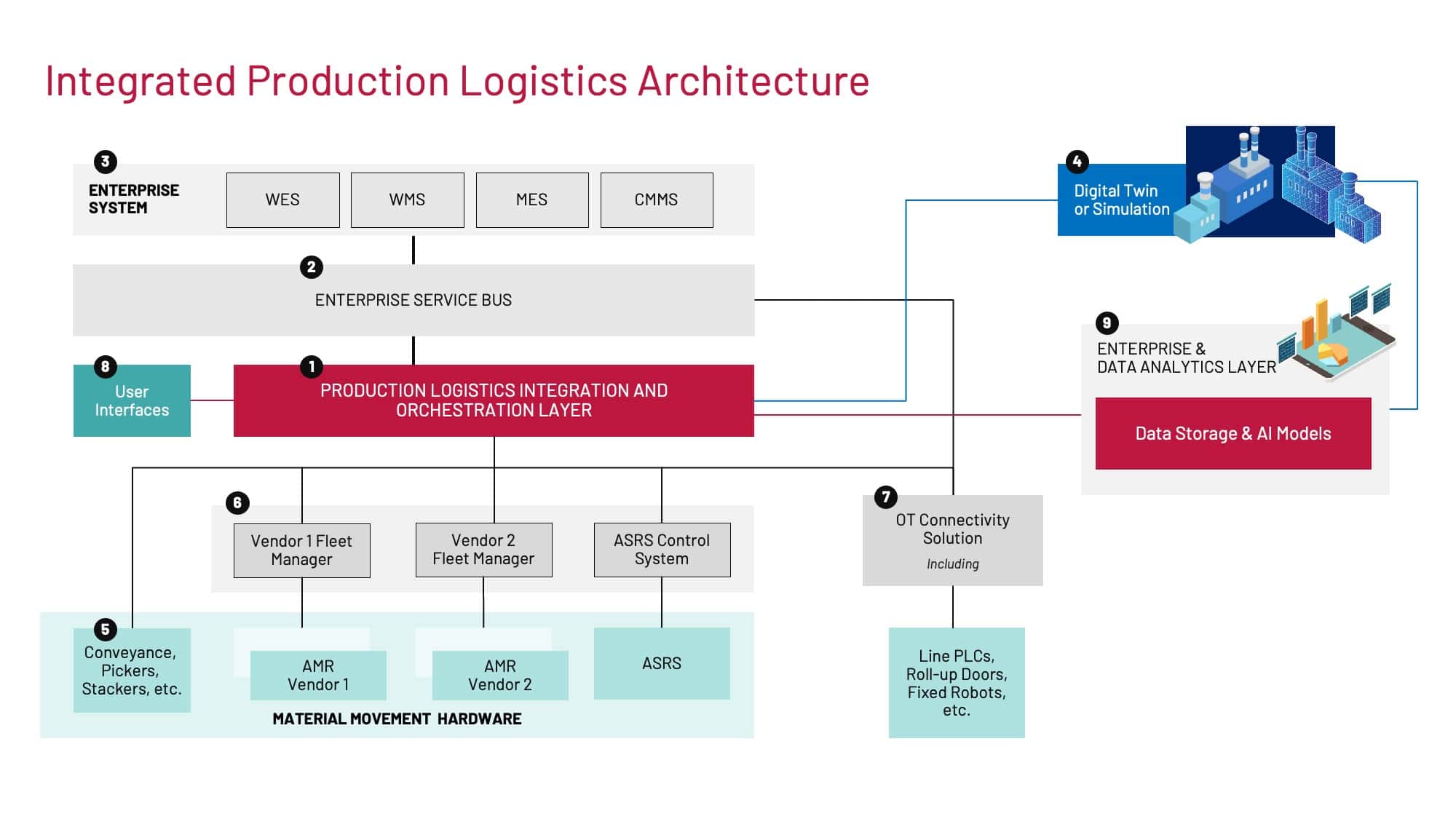
- Production Logistics Integration and Orchestration Layer: Connects and coordinates work between multiple material movement solutions, enterprise systems, and people. It serves as the integration point between automated and manual operations and can provide key functions like scheduling optimization, traffic management, and act as a data broker.
- Enterprise Service Bus: Provides a consistent interface to core enterprise systems (e.g., MES, ERP), avoiding the need for point integrations.
- Enterprise Systems (WES, WMS, MES, CMMS): Manage orders, inventory, production schedules, tracking, and maintenance plans.
- Digital Twin or Simulation: Continuously optimize and test new processes before implementation with this digital representation of material flows. This twin can serve as a foundation for building AI models.
- Material Movement Hardware: Includes robots, conveyance systems, pickers, stackers, or storage and handling equipment that moves material within the facility.
- Fleet Managers: Coordinate and optimize the operations of a group of robots, handling tasks like deployment, configuration, task scheduling, and performance monitoring.
- Operational Technology Connectivity Solution: Connects to multiple hardware sources and translates or interprets various protocols, ensuring seamless communication between different systems.
- User Interfaces: Allow humans to manage operations with interfaces such as industrial HMIs and web applications. Middleware can provide a “single pane of glass” view, reducing the need for multiple interfaces.
- Enterprise and Data Analytics Layer: Logistics data should be captured, historized, and contextualized in the same spirit as production data. Includes tools for processing data, building analytical models, and visualizing performance.
Each of these elements has a role to play and should be considered in a successful integrated production logistics architecture or roadmap.
How to Get Started
Successful programs involve strategic planning, organizational change management, leadership commitment, and demonstrating success prior to rollouts.
To achieve transformational integrated production logistics, take a holistic view of operations. Begin with an assessment that considers multiple lead sites and benchmarks potential benefits. This initial strategic assessment should:
- Prioritize material moves based on feasibility and operational value.
- Identify lead sites that can serve as models for scaling.
- Articulate the value proposition to the organization.
- Define the delivery structure, governance, and partnerships needed for scaling.
- Benchmark sites and assess their readiness.
- Advance lead sites to pre-spend stage for capital requests.
- Define the implementation roadmap.
- Present the target state architecture to achieve integration, coordination, and optimization of automation equipment.
The result of this initial strategic assessment will provide the required guidelines, technical recommendations, and actionable insights to align stakeholders, secure funding, and ensure a successful implementation of transformational integrated production logistics.
The Opportunities for Success
Early adopters of integrated production logistics have an opportunity to outpace their competition. Advancements in material movement technology, combined with the right market dynamics, are creating a new wave of automation investment. Establishing a sustained competitive advantage requires scale and deeply integrated solutions. Digital executives should assess their readiness for this new wave of automation and prioritize integrated production logistics as one of the most transformational opportunities for I4.0 advancement. M
About the authors:

Austin Locke is Principal – Global Lead of Data Science and AI at Rockwell Automation Digital

Braun Brennecke is Senior Manager, Data Science and AI at Rockwell Automation Digital
